
Prato Cathedral, or Cathedral of Saint Stephen, is a Roman Catholic cathedral in Prato, Tuscany, Central Italy, from 1954 the seat of the Bishop of Prato, having been previously, from 1653, a cathedral in the Diocese of Pistoia and Prato. It is dedicated to Saint Stephen, the first Christian martyr.
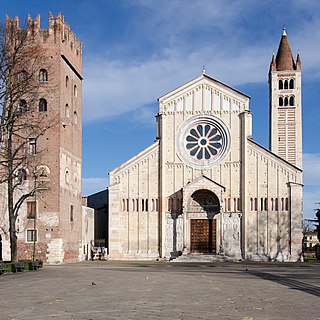
The Basilica di San Zeno is a minor basilica of Verona, northern Italy constructed between 967 and 1398 AD. Its fame rests partly on its Romanesque architecture and partly upon the tradition that its crypt was the place of the marriage of Shakespeare's Romeo and Juliet.
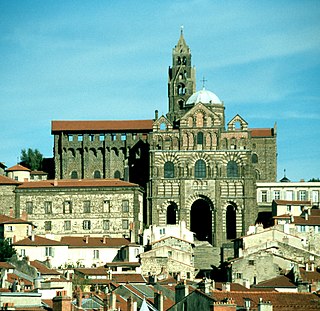
Le Puy Cathedral is a Roman Catholic church located in Le Puy-en-Velay, Auvergne, France. The cathedral is a national monument. It has been a centre of pilgrimage in its own right since before the time of Charlemagne, as well as being a stopover on the pilgrimage route to Santiago de Compostela. Since 1998 it has been part of a multi-location UNESCO World Heritage Site along France's Santiago pilgrimage routes. It is the seat of the Bishop of Le Puy.

The Diocese of Latina-Terracina-Sezze-Priverno is a Latin Church ecclesiastical territory or diocese of the Catholic Church in Lazio, Italy. It was established under this name in 1986. It is the continuation of the Diocese of Terracina, Priverno e Sezze, whose existence was confirmed by Pope Honorius III in 1217, as a joining of the Diocese of Terracina with the Diocese of Priverno and the Diocese of Sezze under a single bishop. It is immediately exempt to the Holy See.

Pistoia Cathedral, or Cathedral of Saint Zeno is the main religious building of Pistoia, Tuscany, central Italy, located in the Piazza del Duomo in the centre of the city. It is the seat of the Bishop of Pistoia and is dedicated to Saint Zeno of Verona.

Mariano Crociata has been bishop of the Diocese of Latina-Terracina-Sezze-Priverno since 19 November 2013. He was previously the Secretary-General of the Italian Episcopal Conference (CEI), the first to come from a southern Italian diocese, and earlier served as Bishop of Noto.

Santa Maria di Nazareth is a Renaissance church in the town of Sestri Levante, in the Gulf of Tigullio in the Metropolitan City of Genoa. Located in the center of the old village of Sestri Levante, adjacent to the town hall, its parish community is part of the Diocese of Chiavari.
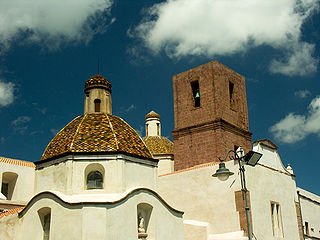
Bosa Cathedral, dedicated to the Immaculate Conception, is a Roman Catholic cathedral in Bosa, Sardinia, Italy. It is a co-cathedral of the Diocese of Alghero-Bosa; before the creation of the merged diocese in 1986 it was the seat of the Bishop of Bosa.

The Metropolitan Cathedral of Saint Agatha, usually known as the Catania Cathedral, is a Roman Catholic cathedral in Catania, Sicily, southern Italy. It was the seat of the Bishops of Catania until 1859, when the diocese was elevated to an archdiocese, and since then has been the seat of the Archbishops of Catania.
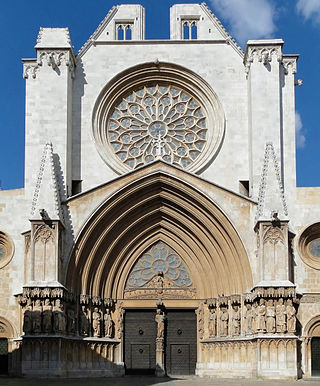
The Primatial Cathedral of Tarragona is a Roman Catholic church in Tarragona, Catalonia, Spain. The edifice is located in a site previously occupied by a Roman temple dating to the time of Tiberius, a Visigothic cathedral, and a Moorish mosque. It was declared a national monument in 1905.

Castelsardo Cathedral is a cathedral in Castelsardo, northern Sardinia, Italy, and is dedicated to Saint Anthony the Great. It became the seat of the bishop of Ampurias in 1503. In 1839 the diocese of Ampurias was merged into that of Tempio, and the episcopal seat moved to Tempio Cathedral, when that of Castelsardo became a co-cathedral, as it remains in the present diocese of Tempio-Ampurias.
Domenico Pecile was an Italian Prelate of Roman Catholic Church.
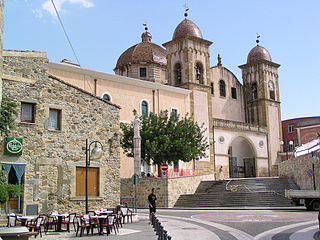
Ales Cathedral is the parish church of Ales, a small town in the province of Oristano, Sardinia, Italy, and the cathedral of the diocese of Ales-Terralba. The dedication is to Saint Peter and Saint Paul.

Avellino Cathedral is a Roman Catholic cathedral dedicated to the Assumption of the Virgin Mary and Saint Modestinus in Avellino, Campania, Italy. It is the seat of the bishops of Avellino.

Terracina Cathedral is a Roman Catholic cathedral in Terracina, Italy, dedicated to Saint Caesarius of Terracina and formerly to Saint Peter. Formerly the episcopal seat of the diocese of Terracina, it is now a co-cathedral in the diocese of Latina-Terracina-Sezze-Priverno.

Holy Name of Jesus Cathedral is a Catholic cathedral that is the seat of the Diocese of Raleigh, replacing Sacred Heart Cathedral.
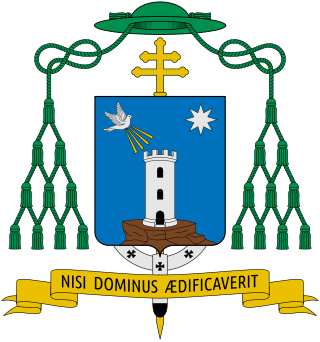
Felice Accrocca is an Italian prelate of the Catholic Church who has been the Archbishop of Benevento since 2016.
Juan Gálvez was a Roman Catholic prelate who served as Bishop of Terracina, Priverno e Sezze (1500–1507).
Pomponio de Magistris was a Roman Catholic prelate who served as Bishop of Terracina, Priverno e Sezze (1608–1614).

Gaeta Cathedral, more formally the Cathedral of Saints Erasmus and Marcian and St. Mary of the Assumption, is the most important place of Catholic worship in Gaeta, Italy, mother church of the archdiocese of the same name and seat of the parish of Mary Most Holy Assumed into Heaven.


















